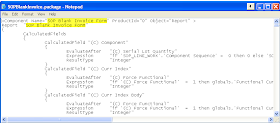But, then, my coworker Cindy Boersma asked if I knew I could make the SOP Blank History Invoice Form look exactly like the SOP Blank Invoice Form using the same method. Holy cow! No, I did not, although it all makes logical sense. Since all the information, including table names, is in the package file. So, here are the basic steps, adapted from Cindy's notes. As always, please make sure you either keep backups of the package files or the reports dictionary before attempting any of these steps to avoid the loss of your modifications :)
1. Export the report you want to use as the "basis" of the other report (Microsoft Dynamics GP-Tools-Customize-Customization Maintenance-Export)
2. Open the package file created using Notepad
3. At the top of the package file, you should see the component and report name as highlighted in the screenshot below
4. Simply edit these two (2) references to the report name to match the report that you wish to copy the package to (for example, SOP Blank History Invoice Form"). Check Report Writer if you have issues finding the report name (it needs to be the name used in Report Writer for the report, which is also the name that appears across on the top border of the Screen Output window when you print a report to the screen-- NOT the name that prints on the report itself, this is not always the report writer name).
5. Next, if the report you are copying to uses different tables (e.g., the SOP Blank History Invoice Form uses the SOP history tables while the SOP Blank Invoice Form uses the SOP work tables), you will need to use Edit-Replace in Notepad to make the substitutions. Now, in this case, it assumes that the field names in the tables are the same. So we find/replace SOP_LINE_WORK with SOP_LINE_HIST and SOP_HDR_WORK with SOP_HDR_HIST. And here are the results...
Not only did we replace the component and report identifiers, but the find/replace also updated the table references in the report package as well.
6. Now, we can import our package file back in to GP, Microsoft Dynamics GP-Tools-Customize-Customization Maintenance-Import. Remember, no other users can be in Dynamics GP when you complete this process (assuming you are accessing a shared reports dictionary).
And there you go. Creating a historical invoice that looks identical to the standard invoice in minutes! So cool. And why I love this job-- learn something new (even if it was sooo obvious) every day!
Christina Phillips is a Microsoft Certified Trainer and Dynamics GP Certified Professional. She is a supervising consultant with BKD Technologies, providing training, support, and project management services to new and existing Microsoft Dynamics customers. This blog represents her views only, not those of her employer.


No comments:
Post a Comment